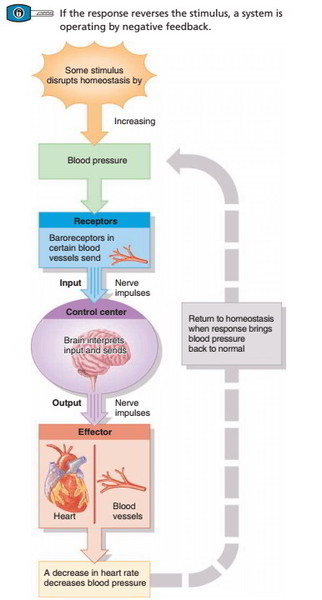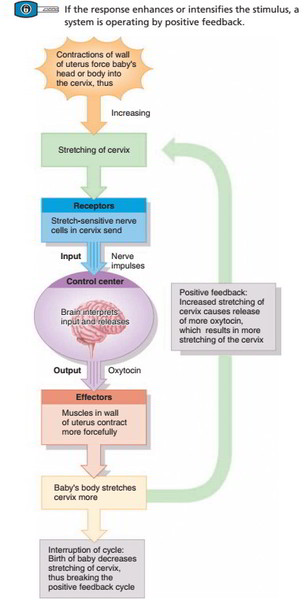Homeostasis, a term presented by W. B. Cannon, describes the mechanism by which the constancy of the internal environment is maintained and ensured Homeostasis is the maintenance of a fairly steady internal environment by self-regulating physiological processes Homeostasis keeps body temperature and the structure of blood and interstitial fluids within their regularrange This fairly steady internal environment is maintained in spite of that internal and external aspects have the tendency to change body temperature, and products are continually going into and leaving the blood and interstitial fluid.
The aspects associated with the maintenance of internal environment can be summed up as: Transport of ECF, Maintenance of pH of ECF (acid– base balance), Regulation of temperature, Maintenance of water and electrolyte balance, Supply of nutrients, oxygen, enzymes and hormones, Elimination of metabolic and other waste products, and Reproduction.
All the organ systems operate in an interdependent way to preserve homeostasis. For instance, modifications in one system have the tendency to impact several other body systems For that reason, any interruption in one body system has the tendency to be corrected however might interrupt another body system The internal environment is maintained by means of a dynamic stability where there is consistent change taking place in order to preserve homeostasis. Malfunctioning or overcompensation in a homeostatic mechanism can result in disorders and diseases.
Negative-feedback Mechanism
The dynamic stability of homeostasis is mostly maintained by physiologic processes called negative feedback mechanisms Body fluid structure and other physiological variables vary near a regular worth, called a set point, and negative-feedback mechanisms are utilized to keep these variables within their regular range For a negative-feedback mechanism to work, it has to have the ability to keep track of and react to any modifications in homeostasis. The structure of the negative-feedback mechanism enables it to work in precisely this way and is an excellent example of how anatomical structure matches function.
Some Crucial Negative Feedback Control Systems
To keep track of a physiological variable, a negative-feedback mechanism makes use of a receptor to spot discrepancy from the set point and send out a signal alerting the integrating center about the discrepancy. The integrating center, which is the body area that understands the set point for the variable, processes the info from a receptor and identifies the course of action that is required. It then sends out a signal that triggers an effector. The effector will perform the required response inning accordance with the instructions of the integrating center and return the variable back towards the set point. In a negative-feedback mechanism the response of the effector will constantly be the reverse of the modification found by the receptor
Once the set point is reached, the negative feedback mechanism will instantly shut off. Our body’s capability to preserve fairly consistent blood glucose levels depends on negative-feedback mechanisms. When blood glucose levels start to increase, as they do after a meal, there are receptors in the pancreas that can spot this stimulus (modification). The beta cells of the pancreas serve as an integrating center and release the hormone insulin in response to this modification. Insulin journeys through the blood to numerous effectors, among which is the liver. Insulin triggers the liver cells to take excess glucose from the blood stream and therefore reduce the blood glucose level back towards regular. The pancreas has other receptors that can spot reductions in blood glucose, such as happens in between meals. The alpha cells of the pancreas, functioning as the integrating center, release the hormone glucagon. Glucagon triggers the liver to release glucose into the blood stream, which will increase blood glucose back towards regular.
It is necessary to keep in mind that the response of the integrating center will be more powerful if the initial stimulus is further from regular. For instance, if the blood glucose level increases greatly from the regular range, triggering hyperglycemia (blood glucose level above regular), the quantity of insulin the beta cells release will be more than the quantity launched if the blood glucose level rises however is still within the regular range This type of response is called a graded response due to the fact that it can react on various levels.
Examples of a feedback mechanism:
1. When the blood pressure all of a sudden increases or reduces, it starts a series of responses that aims to bring the blood pressure to regular levels.
2. When thyroxine secretion is more, it prevents the secretion of thyroid stimulating hormone from pituitary so that, thyroxine is not produced from the thyroid gland.
Positive-Feedback Mechanisms
Positive-feedback mechanisms make use of the exact same fundamental components as negative-feedback mechanisms. Nevertheless, the result of a positive-feedback mechanism is extremely various from that of a negative-feedback mechanism. A positive-feedback mechanism is utilized when the coming from stimulus has to be magnified and continued in order for the wanted result to happen.
A couple of examples of positive-feedback mechanisms consist of fever, activation of the immune response, formation of embolism, particular elements of digestion, and uterine contractions of labor. If you think of blood clot formation, embolism do not form “usually”; when they start to form, this happens rapidly and entirely in order to stop blood loss. This is a needed mechanism for total homeostasis.
Positive-feedback mechanisms can be hazardous due to the fact that they do not have the capability to stop by themselves. They will continue to enhance the result of the initial stimulus, which can press the body dangerously from homeostasis, till the cycle is disrupted by an outdoors aspect. For instance, an unchecked fever can increase body temperature to a point that is deadly. For this factor, positive-feedback mechanisms are utilized for unusual occasions within the body, instead of for the day-to-day maintenance of homeostasis.
Even more, in some cases positive feedback can serve beneficial functions, e.g. under following situations: Clot formation followed by rupture of vessels is sped up by the vicious circle of thrombin formation This stops the bleeding. Child birth throughout labour is facilitated by gradually increasing uterine contractions due to positive feedback from extending of the cervix by head of the baby Generation of nerve signals by the vicious circle of progressive leak of Na+ ions from the channels established following stimulation of membrane of nerve fiber is because of the positive feedback.



 (49 votes, average: 4.49 out of 5)
(49 votes, average: 4.49 out of 5)